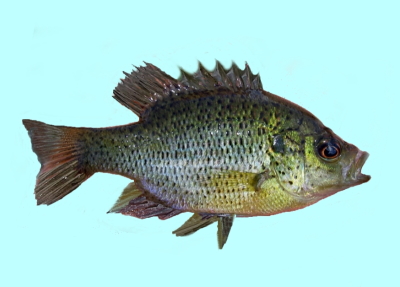|
|
Spotted sunfish, its habitats, description, fishing methods.
Sunfish are the fish that most young anglers catch while learning the sport of fishing. Pumpkinseed do not grow big, but they are nice to look at and they are very aggressive. They prefer slack water in ponds, lakes and some streams, usually hang out near the shorelines. They feed on insects, worms and tiny bait fish.
A combination of understanding the fish and the techniques used to catch them will help you to hook more fish to the end of your line. Better knowing and understanding of the fish that you are trying to catch will make you a more successful angler, whether you are fishing for trout on a river or surfing on the beach or trolling on the open water.

|
Spotted Sunfish - Lepomis punctatus, also known as stumpknocker and bream. It is found throughout the Florida peninsula and west to the Perdido River. North America: Atlantic and Gulf Slope drainages from Cape Fear River in North Carolina to Nueces River in Texas, north in Mississippi River basin to central Illinois in the USA; North Carolina, South Carolina, Georgia, most of Florida, Alabama, and southeastern Tennessee. Fish is more common in the south than in the north.
|
Description
Spotted sunfish have thick and ovate body shape, with the length about twice the depth. They can range in color from black to red-orange males to yellow-brown in the females. Usually it is olive-green to brown in color, covered with small black or reddish spots on the base of each scale to form horizontal rows of dots on its sides. On some fish there is a red bar in front of many of the black spots, particularly below the lateral line. These bars give the fish a reddish hue. Some fish have blue on the lower portion of the eye. A 4 year old fish regular is about 6 inches long.
Habitats
The preferred habitat is slow-moving, heavily vegetated streams and rivers with limestone, sand, or gravel substrates. They are virtually ubiquitous inhabiting large rivers to very small heavily vegetated lakes, ponds, pools of creeks. This species is very aggressive and will take almost anything they can attack and catch. They generally feed on the bottom, but sometimes it will rise to the surface to take food. Spotted sunfish will feed on invertebrates, insects and small fishes when they are easy to catch. The bulk of their diet consists of a variety of plants and animals that are usually associated with aquatic vegetation, brush, or rubble.
Spawning
Spawning takes place from May through November. Nest-builders, they likely to be more lonely than some other sunfish. Males are very aggressive and antagonistic toward other fish in its nesting area. The beds are about one foot in diameter and are fanned out by the male, who also stands guard over the eggs and larvae. Spotted sunfish males are polygamous. When female swims into a nesting colony of males, males raise their fins and swish their tail and swimming all around the female back toward their nest. Once the male lures the female into the nest the spawning ritual begins. As soon as the eggs are laid the male depart the female off and then he looks to find another female so she can lay more eggs in his nest. Egg numbers in a nest range from a hundred to several thousand. Spotted female sunfish bounce back from being driven from the nest of their male counterpart. They are polygamous to and they will quickly swim into the nest of another attractive male vying for their attention. Males may welcome about 7 females over several days.
Fishing Methods.
Because of its small size the spotted sunfish has limited value to the angler, but it is an active and fiesty panfish. The same methods of fishing discussed for the redbreast sunfish apply for the spotted sunfish. The flesh is excellent eating quality.
Most of the year sunfish stay in shallow water. Sunfish stay in shallow water throughout the spring and summer usually going no deeper than 20 feet deep. In the late fall, winter and/or ice fishing season look for them in deeper water (9-30 feet deep). In a lake that has a variety of other sunfish it is almost impossible to try to single out and catch one of the species. Sunfish will stick in the same areas and eat mostly the same food.
Often the most effective bait and rig for sunfish is a bobber or slip bobber rig with#6 or #8 hooks with corn, worms or a small leech. The bobber must be small and sensitive, using stick like bobbers rather than round bobbers will improve catch.
Large sunfish usually feed off the bottom. Use a small 1/8-1/4 oz. sliding sinker and a 12 inch leader of the same or lighter line, or use a few small splitshot and no bobber. This method is often more effective when the water is choppy and/or the fish are sluggish. Corn or worms are the best choices for this type of rig. Earthworms, leaches are a very good choice. Crappie minnows can also work. Fish them much the same as you would for crappies. This bait will catch mostly bigger ones only. Always use an ultra light rod so you can cast very tiny baits and feel a tiny sunfish strikes.
Sunfish are common and fun to catch through the ice. During ice cover they tend to stay close to the bottom; from a few inches off to about 3 feet. Use a very small jigging spoon (1/32 or 1/64 oz even) or small jig and tip it with a wax worm, maggots or a small minnow. Use a very small slip bobber, and extremely light 2-4 lb test line in the winter because they can see a heavier lines.
|
|
|

